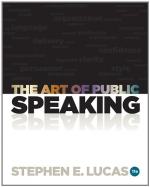It is impossible for anyone—even yourself—to criticise your gestures until after they are made. You can’t prune a peach tree until it comes up; therefore speak much, and observe your own speech. While you are examining yourself, do not forget to study statuary and paintings to see how the great portrayers of nature have made their subjects express ideas through action. Notice the gestures of the best speakers and actors. Observe the physical expression of life everywhere. The leaves on the tree respond to the slightest breeze. The muscles of your face, the light of your eyes, should respond to the slightest change of feeling. Emerson says: “Every man that I meet is my superior in some way. In that I learn of him.” Illiterate Italians make gestures so wonderful and beautiful that Booth or Barrett might have sat at their feet and been instructed. Open your eyes. Emerson says again: “We are immersed in beauty, but our eyes have no clear vision.” Toss this book to one side; go out and watch one child plead with another for a bite of apple; see a street brawl; observe life in action. Do you want to know how to express victory? Watch the victors’ hands go high on election night. Do you want to plead a cause? Make a composite photograph of all the pleaders in daily life you constantly see. Beg, borrow, and steal the best you can get, BUT DON’T GIVE IT OUT AS THEFT. Assimilate it until it becomes a part of you—then let the expression come out.
QUESTIONS AND EXERCISES
1. From what source do you intend to study gesture?
2. What is the first requisite of good gestures? Why?
3. Why is it impossible to lay down steel-clad rules for gesturing?
4. Describe (a) a graceful gesture that you have observed; (b) a forceful one; (c) an extravagant one; (d) an inappropriate one.
5. What gestures do you use for emphasis? Why?
6. How can grace of movement be acquired?
7. When in doubt about a gesture what would you do?
8. What, according to your observations before a mirror, are your faults in gesturing?
9. How do you intend to correct them?
10. What are some of the gestures, if any, that you might use in delivering Thurston’s speech, page 50; Grady’s speech, page 36? Be specific.
11. Describe some particularly appropriate gesture that you have observed. Why was it appropriate?
12. Cite at least three movements in nature that might well be imitated in gesture.
13. What would you gather from the expressions: descriptive gesture, suggestive gesture, and typical gesture?
14. Select any elemental emotion, such as fear, and try, by picturing in your mind at least five different situations that might call forth this emotion, to express its several phases by gesture—including posture, movement, and facial expression.




